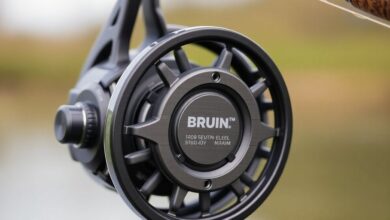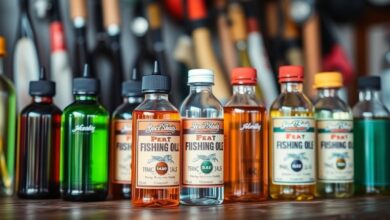Pulleys play a vital role on fishing vessels, commonly known as “blocks.” These essential components help manage the ropes and cables that control various fishing equipment, enhancing efficiency and safety on board. Understanding the different types and functions of these pulleys is crucial for anyone involved in fishing operations.
Key Takeaways
- Pulleys on fishing vessels are called blocks, and they help manage the movement of ropes.
- There are various types of blocks, including single and double sheave blocks, which serve different purposes.
- Specialized blocks like trawl and gin blocks are designed for specific fishing tasks.
- Pulleys provide mechanical advantages, making it easier to lift heavy loads and distribute weight effectively.
- Regular maintenance and safety checks are important to ensure the pulleys function properly and safely.
Understanding the Role of Pulleys on a Fishing Vessel

Pulleys, often called blocks, play a vital role in the operation of fishing vessels. They help manage the movement of lines, which are essential for controlling nets, sails, and other equipment. Here’s a closer look at their significance:
Definition and Function
Pulleys are simple machines that change the direction of a force. On fishing vessels, they are used to lift heavy loads and make it easier to handle fishing gear. For example, a pulley on a ship helps people pull in a heavy fishing net.
Importance in Fishing Operations
The use of pulleys is crucial for several reasons:
- Efficiency: They allow fishermen to lift and lower heavy equipment with less effort.
- Safety: By distributing weight, they reduce the risk of injury when handling heavy loads.
- Versatility: Different types of pulleys can be used for various tasks, making them adaptable to different fishing methods.
Common Materials Used
Pulleys are made from various materials, each chosen for its strength and durability. Common materials include:
- Aluminum: Lightweight and resistant to corrosion.
- Stainless Steel: Strong and durable, ideal for marine environments.
- Plastic: Often used for smaller, less demanding applications.
Pulleys are essential for the smooth operation of fishing vessels, allowing for better control and efficiency in fishing activities.
In summary, pulleys are not just simple tools; they are integral to the success of fishing operations, enhancing both safety and efficiency.
Types of Pulleys Found on Fishing Vessels

Fishing vessels use various types of pulleys, commonly known as blocks, to assist in their operations. Each type serves a specific purpose, enhancing the efficiency of fishing activities.
Single Sheave Block
- A single sheave block has one pulley and is used for simple lifting tasks. It’s effective for redirecting lines and is easy to operate.
- Common uses include:
- Lifting nets
- Adjusting sails
- Managing lines on deck
Double Sheave Block
- The double sheave block features two pulleys, allowing for more complex rigging setups. This type helps distribute the load more evenly.
- Benefits include:
- Changing the direction of a line
- Reducing strain on the line
- Supporting heavier loads
Snatch Block
- A snatch block has a side that opens, making it easy to insert a line without threading it through. This is particularly useful for quick adjustments.
- Ideal for:
- Adding or removing lines under load
- Quick changes during operations
Gantry Blocks
- Gantry blocks are large and mounted on gantries, used for deploying and retrieving nets or gear. They are designed to handle significant weight.
- Common applications include:
- Lifting heavy fishing gear
- Assisting in net retrieval
- Supporting large loads during operations
Pulleys are essential for managing the heavy loads and complex tasks involved in fishing. They provide a mechanical advantage that makes operations smoother and safer.
Summary Table of Pulley Types
| Type | Number of Sheaves | Key Features |
|---|---|---|
| Single Sheave Block | 1 | Simple, effective for lifting |
| Double Sheave Block | 2 | Distributes load, changes direction |
| Snatch Block | 1 (openable) | Quick line adjustments |
| Gantry Block | Varies | Heavy-duty, mounted for large loads |
Specialized Pulleys for Fishing Applications

Fishing vessels use specific types of pulleys, known as blocks, to handle various tasks efficiently. These specialized pulleys are designed to manage heavy loads and improve the overall fishing process.
Trawl Block
A trawl block is essential for trawling vessels. It is built to handle the heavy cables used in trawling operations. These blocks are often large and reinforced to withstand significant forces. Here are some key features:
- Heavy-duty construction
- Designed for high load capacity
- Used in trawling operations
Gin Block
Gin blocks are commonly used for lifting and lowering nets, pots, or other heavy gear. They are robust and can manage substantial weights. Key points include:
- Strong and durable
- Ideal for heavy lifting
- Mounted on masts or booms
Dredge Pulleys
Dredge pulleys help reduce the force needed to pull in heavy dredge teasers. They are crucial when dealing with large and heavy dredges. Here’s how they work:
- Attach the snap connection to the rigger ring or reel clamp.
- Run the teaser line through the sheaves.
- Tie the end to the becket on the pulley.
Specialized pulleys are vital for enhancing the efficiency of fishing operations, allowing for easier handling of heavy equipment.
These specialized pulleys play a significant role in making fishing operations smoother and more effective, ensuring that fishermen can focus on their catch rather than struggling with equipment.
How Pulleys Enhance Fishing Efficiency
Mechanical Advantage
Pulleys provide a mechanical advantage that makes lifting heavy loads easier. By using a system of pulleys, fishermen can reduce the amount of force needed to lift or move equipment. This is especially important when dealing with heavy nets or gear. For example:
- A single pulley can cut the effort needed in half.
- A double pulley can reduce the effort even more.
- Using multiple pulleys can significantly lessen the load on the crew.
Load Distribution
Pulleys help in distributing the weight of heavy loads evenly. This means:
- Less strain on the equipment.
- Reduced risk of damage to the vessel.
- Improved safety for the crew.
Ease of Operation
Using pulleys makes it easier to operate fishing gear. This includes:
- Quick adjustments to nets and lines.
- Smooth movement of heavy equipment.
- Less physical effort required from the crew.
Pulleys are essential for making fishing operations more efficient and safer. They allow fishermen to focus on catching fish rather than struggling with heavy gear.
Maintenance and Safety of Fishing Vessel Pulleys
Routine Inspections
Regular checks are essential to ensure that pulleys are functioning properly. Here are some key points to consider:
- Inspect for wear and tear: Look for any signs of damage or excessive wear on the pulleys.
- Check the lines: Ensure that the ropes or cables are not frayed or damaged.
- Lubricate moving parts: Keeping the pulleys well-lubricated helps them operate smoothly.
Common Issues and Fixes
Pulleys can face various problems. Here are some common issues and their solutions:
- Sticking or jamming: This can often be fixed by cleaning and lubricating the pulley.
- Worn sheaves: If the sheaves are worn out, they may need to be replaced.
- Misalignment: Ensure that the pulleys are properly aligned to avoid unnecessary strain on the lines.
Safety Precautions
Safety is crucial when working with pulleys on fishing vessels. Here are some important precautions:
- Wear protective gear: Always use gloves and safety glasses when handling pulleys.
- Follow proper lifting techniques: Use your legs, not your back, to lift heavy loads.
- Be aware of your surroundings: Ensure that the area is clear of obstacles and other crew members when operating pulleys.
Regular maintenance and safety checks can prevent accidents and ensure smooth operations on fishing vessels.
| Issue | Solution |
|---|---|
| Sticking or jamming | Clean and lubricate |
| Worn sheaves | Replace the sheaves |
| Misalignment | Realign the pulleys |
Historical Evolution of Pulleys in Marine Use
Early Uses in Sailing
Pulleys, often called blocks, have been used in sailing for centuries. They help sailors manage heavy sails and rigging. Early designs were simple, made from wood, and relied on basic mechanics to change the direction of force. This allowed sailors to hoist sails more easily and control their boats better.
Technological Advancements
As technology improved, so did the design of pulleys. Modern pulleys are made from stronger materials like aluminum and stainless steel, which make them lighter and more durable. This evolution has led to:
- Increased load capacity
- Better resistance to corrosion
- Enhanced efficiency in fishing operations
Modern Innovations
Today, pulleys are essential in various marine applications, especially in fishing. They are designed to handle heavy loads and are often used in:
- Trawling: For pulling nets from the water.
- Dredging: To lift heavy equipment.
- General rigging: For various fishing gear.
The evolution of pulleys has significantly improved the efficiency and safety of fishing operations, making them indispensable tools for modern fishermen.
This historical journey shows how pulleys have transformed from simple wooden devices to advanced mechanical systems that enhance fishing efficiency.
Comparing Pulleys with Other Rigging Components
Pulleys vs. Fairleads
Pulleys and fairleads serve different purposes in rigging. Here’s how they compare:
- Pulleys are used to change the direction of a rope and can provide mechanical advantage.
- Fairleads guide the rope smoothly, preventing wear and tear on the vessel.
- Pulleys can handle heavier loads, while fairleads are more about guiding lines.
Pulleys vs. Winches
When comparing pulleys to winches, consider the following:
- Pulleys are simpler devices that redirect force.
- Winches are mechanical devices that wind rope or cable to lift or pull loads.
- Pulleys can be part of a winch system, enhancing its efficiency.
Pulleys vs. Cleats
Pulleys and cleats also have distinct roles:
- Pulleys help in lifting and moving loads.
- Cleats are used to secure lines in place.
- Pulleys allow for movement, while cleats provide stability.
Understanding the differences between these components is crucial for effective rigging on fishing vessels. Each part plays a unique role in ensuring safety and efficiency during operations.
In summary, while pulleys are essential for lifting and redirecting loads, fairleads, winches, and cleats each have their specific functions that complement the overall rigging system. Pulleys are vital for mechanical advantage, while other components enhance stability and control.
Conclusion
In summary, the pulleys found on fishing vessels, commonly known as blocks, play a vital role in managing the heavy loads and lines used in fishing operations. These blocks come in various types, such as single and double sheave blocks, snatch blocks, and trawl blocks, each designed for specific tasks. Understanding these components can help fishermen operate their gear more effectively and safely. Whether lifting nets or guiding lines, these pulleys are essential tools that make fishing more efficient and manageable.
Frequently Asked Questions
What are the main types of pulleys on fishing boats?
Fishing boats use several types of pulleys, commonly known as blocks. These include single sheave blocks, double sheave blocks, snatch blocks, and gantry blocks.
How do pulleys help in fishing operations?
Pulleys make it easier to lift and move heavy fishing gear. They change the direction of ropes, which helps distribute weight and makes pulling easier.
What materials are fishing pulleys made from?
Fishing pulleys are often made from strong materials like stainless steel or aluminum to withstand harsh marine conditions.
Why is maintenance important for pulleys on fishing vessels?
Regular maintenance ensures that pulleys work correctly and safely. It helps to spot any wear or damage that could lead to accidents.
What is the difference between a snatch block and a regular block?
A snatch block has a side that opens, allowing you to easily add or remove a rope without threading it through. Regular blocks do not have this feature.
How have pulleys changed over time in fishing?
Pulleys have evolved from simple wooden designs to advanced materials and engineering, improving their strength and efficiency for modern fishing needs.





